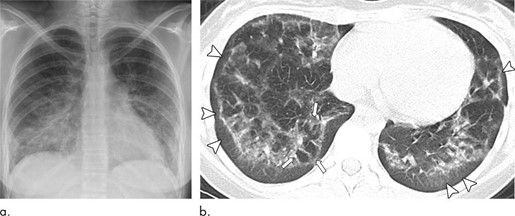(pneumopathy associated with vaping)
Acronym for E-cigarette or Vaping product use Associated Lung Injury.
Severe lung disease, sometimes fatal, associated with the use of inhalation techniques (dabbing, via water pipes for the consumption of psychotropics drugs) or with the vaping of certain liquids, described since 2019. Vaping involves inhaling an aerosol synthesized by e-cigarettes, that includes, for example, nicotine, tetrahydrocannabinol (THC), flavorings and additives (e.g. vitamin E acetate, glycerin, propylene glycol). It usually presents itself as acute lung disease, often resistant to antibiotic therapy but may progress to acute fibrous pneumonia, obliterating bronchiolitis with pneumonic organization or diffuse alveolar lesions.

There is a history of use of e-cigarette products or vaping tetrahydrocannabinol (THC) (potentially contaminated with cyanide or other toxic chemicals)(77 %), a psychoactive molecule extracted from cannabis.
Diagnostic criteria proposed by the CDC:
- Estalished EVALI :
1) smoking or inhalation of cannabis vapor within 90 days prior to onset
2) pulmonary infiltrates (X-ray or CT)
3) absence of signs of infection on admission (complete panel)
4) absence of any other possible cause (cardiac, rheumatological, neoplastic)
- Probable EVALI :
1) smoking or inhalation of cannabis vapour in the 90 days prior to onset
2) pulmonary infiltrates (X-ray or CT)
3) identification of a causative infectious agent, but the health-care team is convinced that this is not the main cause of the clinical picture
4) absence of another possible cause (cardiac, rheumatological, neoplastic)
Treatment: antibiotic therapy, corticosteroid therapy, controlled ventilation, sometimes ECMO
Anesthetic implications:
1) vaping is associated with an increased reactivity of the airways (cough, secretions, asthma)
2) regular consumption of cannabis seems to produce some resistance to the hypnotic agents
3) in the presence of fever in patients who use e-cigarettes or similar devices, check SpO2 on room air and perform a chest X-ray or CT if they present with respiratory or gastro-intestinal problems..
Nobody knows whether passive exposure to vaping as any deleterious effect.
References :
- Elliott EM, Weintraub AY, Francis CR, Lindell RB.
E-cigarette and vaping-associated lung injury.
Anesthesiology 2020; 133: 427-8
- Lynn RSR, Galikin JL.
Cannabis, e-cigarettes and anesthesia.
Curr Opin Anesth 2020; 33: 316-26
- El Chebib H, McArthur K, Gorbonosov M, Domachowske JB.
Anaerobic necrotizing pneumonia: another potential life-threatening complication of vaping?
Pediatrics 2020; 145: e20193204
- Rusy DA, Honkanen A, Landrigan-Ossar MF, Chatterjee D, Schwartz LI et al.
Vaping and e-cigarette use in children and adolescents: implications on perioperative care from the American Society of Anesthesiology Committee on Pediatric Anesthesia, Society for Pediatric anesthesia, and American Academy of Pediatrics section on Anesthesiology and Pain Medicine.
Anesth Analg 2021; 133:562-8.
- Gaik C, Arndt C, Mand N, Bauck M, Schwerk N, Westhoff C, Bittmann I, Wulf H.
Plasmapheresis as therapeutic option in a 16-year-old with EVALI : a case report.
Eur J Anaesthesiol 2024; 41:530–4.
Updated: November 2024